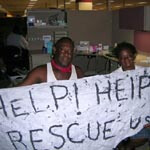
Hundreds of students and faculty from the Health Science Center are responding to the call to help victims of Hurricane Katrina now in shelters in the Alamo City.
Lee Jones, M.D., associate dean for student affairs in the Medical School, said he had to tell some die-hard student volunteers “to pace yourselves and take care of yourselves, those important to you, and your studies.” The first- and second-year medical students are in the midst of the first round of exams of the academic year, but they were out in force over the Labor Day weekend going cot by cot doing health evaluations at KellyUSA, where thousands of Katrina victims are temporarily staying.
Third- and fourth-year medical students, meanwhile, were coming to the shelters even after completing all-night shifts at the Health Science Center’s teaching hospital, University Hospital. “In the midst of this terrible tragedy, it is wonderful to know that we have such awesome people becoming physicians,” Dr. Jones said.
Three other Health Science Center schools – the School of Nursing, the School of Allied Health Sciences and the Dental School – also assisted the disaster victims. The volunteers included 30 fourth-semester community health undergraduate students and 33 faculty members from the School of Nursing.
“We were there Friday afternoon when the first survivors arrived,” said Robin D. Froman, Ph.D., dean of the School of Nursing. “Some individuals put in more than 24 hours over a two-day period.”
Nursing faculty and students triaged patients, assessed vital signs, performed higher-level assessments as needed, helped patients secure prescriptions, administered immunizations, and educated victims newly diagnosed with diabetes and high blood pressure. “We also dramatically assisted a baby who was in a life-threatening state of dehydration,” Dr. Froman said.
Nursing faculty helped plan and establish infrastructure to deliver ongoing services to the survivors, including setting up a pharmacy at the Levi Strauss shelter. Some faculty helped care for children at KellyUSA who were there without parents.
The medical students were no less heroic. In an e-mail to them on Sunday, Dr. Jones said their “kindness, generosity, caring and dedication had moved me to tears the last few days.”
Dr. Jones sent out his first call for student volunteers at 5:30 p.m. Friday, and had 50 yes answers in the first 10 minutes, he said. As of Tuesday morning, he had received 600 responses.
“As we speak, I just got word that your medical students are saving the day,” wrote Mary Ellen Burns, of the United Way of San Antonio & Bexar County, in an e-mail to Dr. Jones. “They are showing up in their scrubs, with their stethoscopes, and being put to work immediately. They are so eager and so capable that they are lifting spirits all around them. Thanks again; you are doing an incredible thing here.”
Richard P. Usatine, M.D., professor of family and community medicine, recounted meeting a couple at KellyUSA who had been stranded on the roof of their apartment building for days without food and water. The man has one leg and got up on the roof of the building with his crutches. “You can’t help but be touched by the tragic and courageous stories of the survivors,” Dr. Usatine said.
Nan Clare, M.D., senior associate dean and associate dean for academic affairs in the Medical School, said the hundreds of medical-student volunteers were organized into shifts to cover the intake and initial assessment of the Katrina victims at KellyUSA. Students were assigned to all four shelters around San Antonio. “The two students who also took a leadership role are Caesar Ricci and Catherine Pollock, both second-year students,” Dr. Clare said. “Caesar and Catherine actually helped the relief agencies to better organize the process at Kelly.”
Outside the buildings at KellyUSA, Gov. Rick Perry was greeted by Francisco G. Cigarroa, M.D., president of the Health Science Center, and members of the Texas Medical Rangers, a volunteer disaster-response unit based at the Health Science Center.
Inside, the governor walked up to three medical students who were checking people’s health status cot by cot. “He came up and thanked them for being young doctors rising to the challenge of this hour,” Dr. Jones said.

